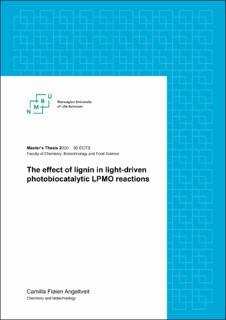| dc.description.abstract | Our understanding of enzymatic hydrolysis of recalcitrant polysaccharides was revolutionized when lytic polysaccharide monooxygenases (LPMOs) were discovered by Vaaje-Kolstad et al. in 2010. LPMOs are copper-dependent redox enzymes, which after a priming reduction of the copper ion, uses the co-substrate, H2O2, to hydroxylate glycosidic bonds. A characteristic solvent-exposed active site and a flat surface enable LPMOs to interact directly with crystalline surfaces. Previous studies have demonstrated that photobiocatalytic systems, using, i.e., chlorophyllin as a photosensitizer, can provide LPMOs with reducing equivalence and H2O2. Lignin has been shown to both function as a reductant and to produce H2O2 in light-driven reactions. The research described in this study aimed to investigate LPMOs activity in light-driven reactions using lignin as a photosensitizer. Various parameters, including lignin concentration, light intensity, enzyme concentration, and superoxide's role in the system, have been studied using the cellulose-active AA10C from Streptomyces coelicolor as model enzyme.
The results from this study show that lignin can promote ScAA10C activity on Avicel, in the 1-10 g/L range. Light exposed reactions using a low lignin concentration show a 10-fold increase in activity compared to similar reactions performed in the absence of visible light. In contrast, the highest activity was observed in reactions with high concentrations of lignin performed in the dark. This can be explained by enzyme inactivation due to accumulation of H2O2, causing oxidative damage of ScAA10C's catalytic site when combining high lignin concentration and light exposure. Adding low amounts of reductant led to minor differences in activity, suggesting that lignin provided ScAA10C with reducing equivalents and co-substrate. On the other hand, increasing the concentration of lignin, AscA, or light intensity led to an increase in LPMO activity. Interestingly, the addition of SOD and Mn(II) both improved the generation of H2O2 from lignin. This confirms that superoxide formation occurs, and that the boost in LPMO activity comes from the accelerated H2O2 formation. Taken together, these results show that lignin can provide ScAA10C, both with reducing power and H2O2 in aerobic conditions and that the production of reactive oxygen species must be carefully controlled to avoid enzyme inactivation.
The observation that visible light-exposed lignin increases the LPMO activity, points to lignin functioning as a photosensitizer. Light exposure leads to oxidation of lignin, which results in the reduction of molecular oxygen to superoxide. Superoxide act both as a reductant for the LPMO and as an intermediate in the generation of hydrogen peroxide, the co-substrate of LPMOs. By using lignin as a photosensitizer, reducing equivalents and co-substrate are produced in situ, and enable oxidative cleavage of cellulose by LPMOs. Further work should focus on determining the limiting factor(s), investigate lignin modifications induced by light exposure, and include anaerobic control reactions. | en_US |
| dc.description.abstract | Vår forståelse av den enzymatiske nedbrytningen av polysakkarider ble revolusjonert i 2010, da Vaaje-Kolstad et al. oppdaget lytisk polysakkarid monooksygenaser (LPMOer). LPMOer er kobberavhengige redoksenzymer, som krever reduksjon av kobberatomet i det aktive setet for å bli aktivert, og bruker deretter kosubsratet H2O2 til å hydroksylere glykosidbinger. Et karakteristisk flatt substrateksponert bindingssete gjør LPMOene spesielt godt egent for interaksjoner med krystallinske overflater. I tidligere studier har det blitt vist at fotobiokatalytiske systemer kan bruke blant annet klorofyllin som et fotosensibiliserende stoff, for å både redusere og tilføre H2O2 til LPMOer. Lignin fungerer som et reduksjonsmiddel, men har også vist en evne til å produsere H2O2 i lysdrevne reaksjoner. Målet med forskningen beskrevet i dette studiet var å undersøke LPMO-aktivitet i lysdrevne reaksjoner ved bruk av lignin som et fotosensibiliserende stoff. Ulike parametere som ligninkonsentrasjon, lysintensitet og enzymkonsentrasjon, i tillegg til superoksidets rolle i systemet ble undersøkt i reaksjoner ved bruk av en celluloseaktiv AA10 LPMO fra Streptomyces coelicolor. | en_US |

